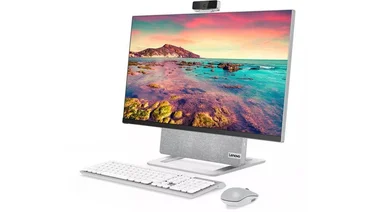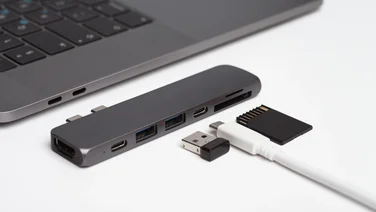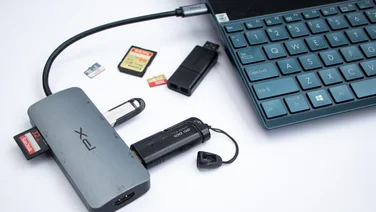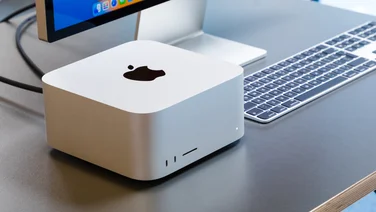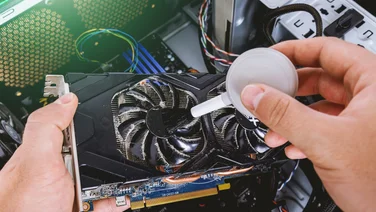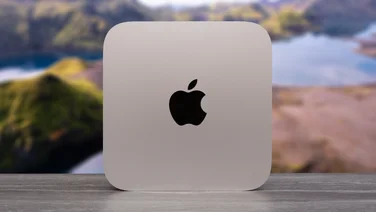To help us provide you with free impartial advice, we may earn a commission if you buy through links on our site. Learn more










- Major hardware bump
- SuperSpeed USB
- Dual-screen support
- Not a serious desktop replacement
I won’t lie. When I heard that the Raspberry Pi 4 Model B would – according to its creators – deliver “desktop performance comparable to entry-level x86 PC systems”, I experienced a frisson of nerdy excitement.
The Raspberry Pi’s lightweight design has tended to restrict it to hobbyist projects and IoT roles, rather than primary desktop or home server duties but the Raspberry Pi 4 Model B is arguably the most significant upgrade in the platform’s history. Could the humble Pi mini PC really be about to conquer the desktop?
Raspberry Pi 4 review: What you need to know
The Raspberry Pi 4 Model B is, physically, almost identical to last year’s Pi 3 Model B+, but the hardware has been updated in several ways. In place of the old HDMI socket it now sports twin micro-HDMI ports, capable of driving a pair of 4K displays at 60Hz. The power socket has also been upgraded, to a modern USB Type-C connector and two of the four USB ports now support SuperSpeed USB 3.










Inside, the Pi 4 gets a more powerful CPU and, while 1GB of RAM remains the default, for the first time you can optionally specify 2GB or even 4GB of RAM. All told, it’s a package that addresses many of the limitations of previous Pi hardware.
Raspberry Pi 4 review: Price and competition
The standard Raspberry Pi 4 comes with 1GB of RAM and costs the same as the Raspberry Pi 3 Model B+, which means you can expect to pay around £34 for the bare board. The 2GB and 4GB versions should come in at around £44 and £54 respectively.
If you don’t need all the power of the new Pi, the cut-down Raspberry Pi 3 Model A+ is still available for just £23. No doubt this will be replaced by a Raspberry Pi 4 Model A at some point but, if previous releases are any guide, that might not happen until the other side of Christmas.
Even dinkier alternatives include the Raspberry Pi Zero WH and the nostalgic BBC micro:bit, both available online for less than £20. Or, more powerful contenders include the Asus Tinker Board (yours for £60 with 2GB of RAM) and the beefy Intel-based Udoo X86 II, which can be had with 4GB of onboard memory for around £230.
Raspberry Pi 4 review: Features and design
One glance and there’s no doubt about it: this is a Raspberry Pi. It comes as a bare board, retaining the familiar 85.6 x 56.5mm form factor, the platform’s signature 40-pin GPIO connector and a microSD card slot for system storage.
But it’s far from a case of same old, same old. For a start, the Raspberry Pi 4 Model B, at last, brings SuperSpeed USB to the Raspberry Pi platform. Its two USB 3 ports are limited to 5Gbits/sec but that’s still an order of magnitude quicker than the legacy USB 2 ports that sit next to them.
The built-in Bluetooth module, meanwhile, has been upgraded from version 4.2 to version 5 and also includes support for Bluetooth Low Energy. Gigabit Ethernet is still present and correct (as is the ability to use PoE via a HAT) and the composite A/V, DSI display and camera ports have made the jump as well.
The dual-band 802.11ac Wi-Fi controller remains unchanged, too, but the Gigabit Ethernet connection is no longer capped at 300Mbits/sec, as in the previous generation, and can now send and receive data at a full 1,000Mbits/sec. In combination with the arrival of USB 3, this opens new possibilities for using the Pi as a networked storage host.










A few other tweaks mean that the new Pi won’t work perfectly with cases and accessories designed for older models, but we think the changes are worth it. For one, the arrival of twin micro-HDMI ports, in place of the old full-size HDMI connector, means you might need to invest in a new cable but it also means you can now effortlessly set up a dual-display configuration, with resolutions up to 4K at 60Hz supported.
The micro-USB power connector has been replaced too, by a USB Type-C socket. That’s a good call, as the older port is no longer conveniently universal and it should be easier to find a Type-C power supply with enough juice to keep the Raspberry Pi 4 Model B running at full speed. It’s worth noting, however, that due to some strange design decisions, there are some USB Type-C power adapters and cables that will not work properly with the Raspberry Pi 4, notably those that are more powerful and are “e-marked”.
That brings me to the core upgrade. The Raspberry Pi 4’s 1.5GHz Broadcom BCM2711 processor might not sound like a huge step up from the last generation’s 1.4GHz BCM2837, but clock speeds don’t tell the whole story. The older model was based on the mid-range ARM Cortex A53 microarchitecture, while the new one uses an A72 design that’s optimised for performance.
This gives the Raspberry Pi 4 Model B a substantial speed boost over previous models, as we’ll see below. It also means you get a more powerful GPU than ever before, which supports OpenGL ES 3 graphics (up from the older ES 2 standard), and gains the ability to decode 4K H.265 video at 60fps, on top of the older Pi’s support for decoding and encoding H.264 streams.
To top it all off, the additional RAM options provide headroom for bigger, more demanding tasks – although note that the memory modules are soldered onto the board, so you can’t start small and upgrade later.










Raspberry Pi 4 review: Performance
The Raspberry Pi 4 Model B is certainly faster than its predecessors; the latest synthetic benchmarks show major improvements in almost every type of operation. It’s a much bigger step up than the previous progression, from the Raspberry Pi 3 Model B to the B+.



So far, so good. However, as I’ve mentioned, this upgrade isn’t just about number-crunching. The Raspberry Pi Foundation has been talking up the Raspberry Pi 4’s potential as a general-purpose desktop and so, alongside our usual set of tests, I also tried running our standard desktop benchmarks. This was gratifyingly easy to do since they’re built on the freeware ImageMagick, Handbrake and VLC tools, all of which are included in the latest release of Raspbian.
Here the Pi stumbled a little. While the upgraded CPU has its strengths, the system as a whole clearly isn’t designed for chewing through large datasets, and the top-end 4GB version of the Raspberry Pi 4 scored a mere 4.9 in the image-editing test, 8.3 in the video-editing test and 7 in the multitasking test, for an overall score of 7. To put that into context, our baseline PC (a Core i5-4670K desktop) processed our folder full of 40-megapixel images in 1min 44secs, while the Pi took around 35 minutes. On a 1GB Pi the tests wouldn’t run at all, crashing out right away with an out-of-memory error.










Our benchmarks also revealed that the Pi 4’s CPU gets hot quite quickly under intensive load. While I was running the tests, the thermal warning icon popped up repeatedly, indicating that the clock speed had been reduced to prevent overheating. If you really want to get the best from the Pi 4’s hardware, you’ll need to address the heat issue.
Happily, in keeping with the Pi philosophy, there are plenty of cheap and charming solutions on offer. There’s no official cooling system for the Pi, but I was able to buy an unbranded adhesive heatsink and a compact case fan from thepihut.com for a grand total of £3.










Since the standard Pi board and case don’t have any mountings for a fan, I ended up removing the case lid and sticking mine directly onto the board using Blu Tack: for a neater, more permanent solution you may need to customise your case, or pay a little more for a fan that’s designed specifically for the Pi.
While my cooling solution may not have been elegant, it successfully banished the throttling indicator. The image-editing score barely benefited, rising only from 4.9 to 5, but performance in the demanding video-editing and multitasking tests was more or less doubled, to 18.6 and 13.6 respectively, resulting in an overall score of 13.9.
Clearly, an aftermarket fan is the key to realising the Pi’s full performance potential – although even then it’s a stretch to call the Raspberry Pi a viable desktop replacement. Be aware too that a fan will tie up the 5V power pins of your GPIO header (unless you use an outboard power source) and there’s no clever technology here to vary its speed according to the system’s needs: the low-cost model I tried made an audible whirring sound for the whole time the Pi was powered on.
I found myself also wondering whether things could be improved by reducing the Pi’s reliance on low-bandwidth microSD storage. Since the Raspberry Pi 4 gives you the option of connecting high-speed external media via USB 3, I experimentally tried repeating the image-editing test with the source and destination files located on an external SSD (an Adata SU900 SSD connected via a Seagate GoFlex USB to SATA cable if you must know the full details). In the event, this made very little difference: the test score was lifted only fractionally to 5.3.
Performance update
Since this review was originally published, two firmware updates have been released for the Raspberry Pi 4. The first, which came just a few days after the release of the hardware, was designed specifically to make the USB controller run cooler; previously this had been one of the Pi’s hottest components, contributing to high internal temperatures that hindered processor performance.
When we retested the Pi with the new firmware, we found that the CPU was indeed able to run at full speed for longer. I saw a 14% boost in our image-editing benchmark and a 19% improvement in the video-editing test; even the intensive multitasking test finished 5% faster. To put that into context, however, the update takes the Pi 4 from an overall benchmark score of 7 to 7.5 – hardly a transformative boost.
It was also discovered that USB performance could be reduced by the new firmware – and to address this a second update was released in September 2019. This restored USB speeds to where they should be, and the good news is that, this time around, CPU performance wasn’t compromised.
If you’d been hoping to see any further benefits that might bring the Pi 4 closer to desktop PC levels of performance however then you’re in for a disappointment. I repeated our benchmarks after installing the update and saw results that were within a few percentage points of the original scores.
Raspberry Pi 4 review: Verdict
Is the Raspberry Pi 4 Model B viable as a desktop PC? Well, perhaps. As you move around the Raspbian desktop everything feels slick and responsive and the enhanced video hardware lets you enjoy HD movies on one monitor while you’re working on a second. If you go for the 2GB or 4GB model, you can open a decent number of browser tabs too.
Yet while this is the fastest Pi ever, it’s still far slower than a mainstream desktop. That may not be apparent when you’re writing emails or composing clerihews in LibreOffice but kick off a medium-weight workload – such as editing a photo, encoding an MP3 or zipping up a bundle of files – and the performance gap is unmissable. It may be only a few generations before the Pi really can be called a mainstream personal computer but we’re not there yet.
So let’s set aside such unrealistic ambitions. The Raspberry Pi was originally conceived as a fun, accessible and, above all, affordable platform for programming, home automation projects, or simply tinkering with Linux. The Raspberry Pi 4 Model B does all of that in a package that’s slicker and more versatile than ever, for the same rock-bottom price as the original model.
Look at it like that and it’s impossible to feel disappointed. No, the Raspberry Pi isn’t ready to replace your main PC but, on its own terms, it’s a fantastic update to what was already an irresistible little computer.
| Raspberry Pi 4 specifications | |
|---|---|
| Processor | 1.5GHz quad-core Broadcom BCM2711B0 (ARMv8-A) |
| Graphics | Broadcom VideoCore VI |
| RAM | 1GB/2GB/4GB LPDDR4 |
| Storage | microSD |
| Wireless | Dual-band 802.11ac Wi-Fi; Bluetooth 5 and LE |
| Ethernet | Full-speed Gigabit Ethernet |
| GPIO | 40-pin header |
| Dimensions | 88 x 58 x 19.5mm |
| Ports | 2 x micro-HDMI (4K 60Hz), 2 x USB 3, 2 x USB 2, Gigabit Ethernet, USB Type-C (power only) 3.5mm audio jack with composite video support, camera serial interface, display serial interface |


